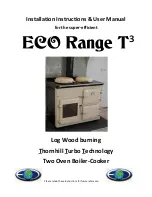
General
12
information
Surfaces
Aluminum
& Vinyl
Control Panel and Trim Pieces
Glass, Painted and Plastic
Control Knobs, Body Parts, and
Decorative Trim
Stainless Steel (some
models)
Oven Door & Drawer
Front Panel
Surface Elements and Drip
Bowls
Porcelain Enamel
Broiler Pan and Insert, Door
Liner, Body Parts and Warmer
Drawer and Drawer Cavity
How to Clean
Use hot, soapy water and a cloth. Dry with a clean cloth.
Before cleaning the control panel,
turn all controls to OFF and remove the control knobs. To
remove, pull each knob straight off the shaft. Clean using hot, soapy water and a dishcloth.
Rinse with a clean water and a dishcloth. Rinse. Be sure to squeeze excess water from the
cloth before wiping the panel; especially when wiping around the controls. Excess water in
or around the controls may cause damage to the appliance.Be sure to rinse the cleaners as
bluish stains may occur during heating and cannot be removed. To replace knobs after
cleaning, line up the flat sides of both the knob and the shaft; then push the knob into place.
For general cleaning
, use hot, soapy water and a cloth.
For more difficult soils and built-up
grease
, apply a liquid detergent directly onto the soil. Leave on soil for 30 to 60 minutes. Rinse
with a damp cloth and dry.
DO NOT
use abrasive cleaners on any of these materials; they
can scratch. To remove control knobs, turn to the OFF position; grasp firmly and pull straight
off the shaft. To replace knobs after cleaning, line up the flat sides of both the knob and the
shaft; then push the knob into place.
Cleaners made especially for stainless steel as Stainless Steel Magic, or other similar cleaners
are recommended. Always follow the manufacturer's instructions. Be sure to rinse the
cleaners as bluish stains may occur during heating and cannot be removed.
Surface elements can be unplugged and removed to make cleaning the drip bowls easier.
The surface elements clean themselves when they are turned on. Food spilled on a hot
element will burn off. Food spilled on a cold element can be cleaned with a damp cloth
___
any
remaining soil will burn off the next time element is used.
NEVER IMMERSE A SURFACE
ELEMENT IN WATER
. To remove surface element and drip bowls, follow the instructions
under
General Cleaning
.
To clean drip bowls, wash in hot, soapy water or in the dishwasher. Rinse and dry while still
warm. Hard-to-remove, burned-on soils can be removed by soaking the drip bowls for about
20 minute in a slightly diluted liquid cleanser or solution made of equal parts ammonia and
water. A nylon scrubber may be used after soaking.
DO NOT
use abrasive cleanser or steel
wool, as they will scratch the surface. Always rinse with clean water and polish, and dry with
a soft cloth. To replace drip bowls and surface elements, follow the instructions under
General Cleaning
.
Gentle scouring with a soapy scouring pad will remove most spots. Rinse with a 1:1 solution
of clear water and ammonia.
If necessary
, cover difficult spots with an ammonia-soaked
paper towel for 30 to 40 minutes. Rinse with clean water and a damp cloth, and then scrub
with a soap-filled scouring pad. Rinse and wipe dry with a clean cloth. Remove all cleaners
or the porcelain may become damaged during future heating.
DO NOT
use spray oven
cleaners on the cooktop.
General Cleaning
Cleaning Various Parts of Your Range
Before cleaning any part of the range, be sure all controls are turned OFF and the range is COOL. REMOVE SPILLOVERS AND
HEAVY SOILING AS SOON AS POSSIBLE. REGULAR CLEANING WILL REDUCE THE NUMBER OF MAJOR CLEANING LATER.
Summary of Contents for FED355CCTI
Page 25: ...Notes ...












































